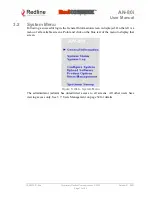
Red
CONNEX
TM
AN-80i
User
Manual
70-00072-01-04b
Proprietary Redline Communications © 2007
October 31, 2007
Page 30 of 94
Remote Frequency Ranges:
When settings are displayed in this table, the frequency scan intervals have been
downloaded from the PTP Master. Setting scan intervals in the PTP Master is optional.
When present, these settings override the local settings and are used whenever the PTP
Slave has deregistered and is scanning for a PTP Master. This list is not saved
permanently, and is discarded when the PTP Slave is rebooted.
Reload
: Display the saved (Local) scan intervals.
Save
: Click to verify the range settings, and if valid, add these to the Local Frequency
Range list. An event message will be entered in the system log indicating the results of
the test.
Important
: Clicking the Save button does not save changes to non-volatile memory. To
permanently save changes, click Save at the bottom of the System Configuration
screen.
Test
: Click to check the range settings and add these to the Local Frequency Range list
(if valid). This action does not save the changes to non-volatile memory.
Operating Notes
If no scan intervals are defined, the PTP Slave will scan all frequency ranges for the
enabled region. If scan intervals are defined, only the listed channels will be scanned for
a PTP Master. If the PTP Slave checks all scan intervals three times without locating and
registering with a PTP Master, the scanning mode is changed to include all frequency
ranges for the enabled region (until registration or reboot).
The PTP Master can also be programmed with a list of scan intervals. When the PTP
Slave registers with a PTP Master that has frequency ranges defined, the list is
transmitted to the PTP Slave and is displayed as Remote Frequency Ranges. When
present, the scan intervals in the Remote Frequency Ranges table are used exclusively
during autoscan (Local Frequency Ranges are ignored). The Remote Frequency Ranges
remain in effect until the PTP Slave is rebooted.
Tx Power [dBm]
: Enter the transmit power level (dBm). This setting is for the
transceiver output only. The actual EIRP depends on the gain of the connected antenna.
Important
: Where required by local regulations, the maximum operational power per
channel for a specific antenna must not exceed the maximum allowable EIRP levels.
Refer to the FCC and CE notices in this manual. The RF output power settings must be
professionally programmed by the manufacturer or a trained professional installer.
See Table 4: Web - Max. Power (in dBm) and Modulation to determine the maximum
transmit power level available at each modulation setting. When ATPC is enabled, the Tx
power will be automatically adjusted to achieve optimum performance.
Table 4
:
Web - Max. Power (in dBm) and Modulation Settings
Modulation
BPSK
QPSK
16 QAM
64 QAM
Code Rate
1/2 3/4 1/2 3/4 1/2 3/4 2/3 3/4
Max Tx Power
20 20 20 20 20 20 17 17
















































